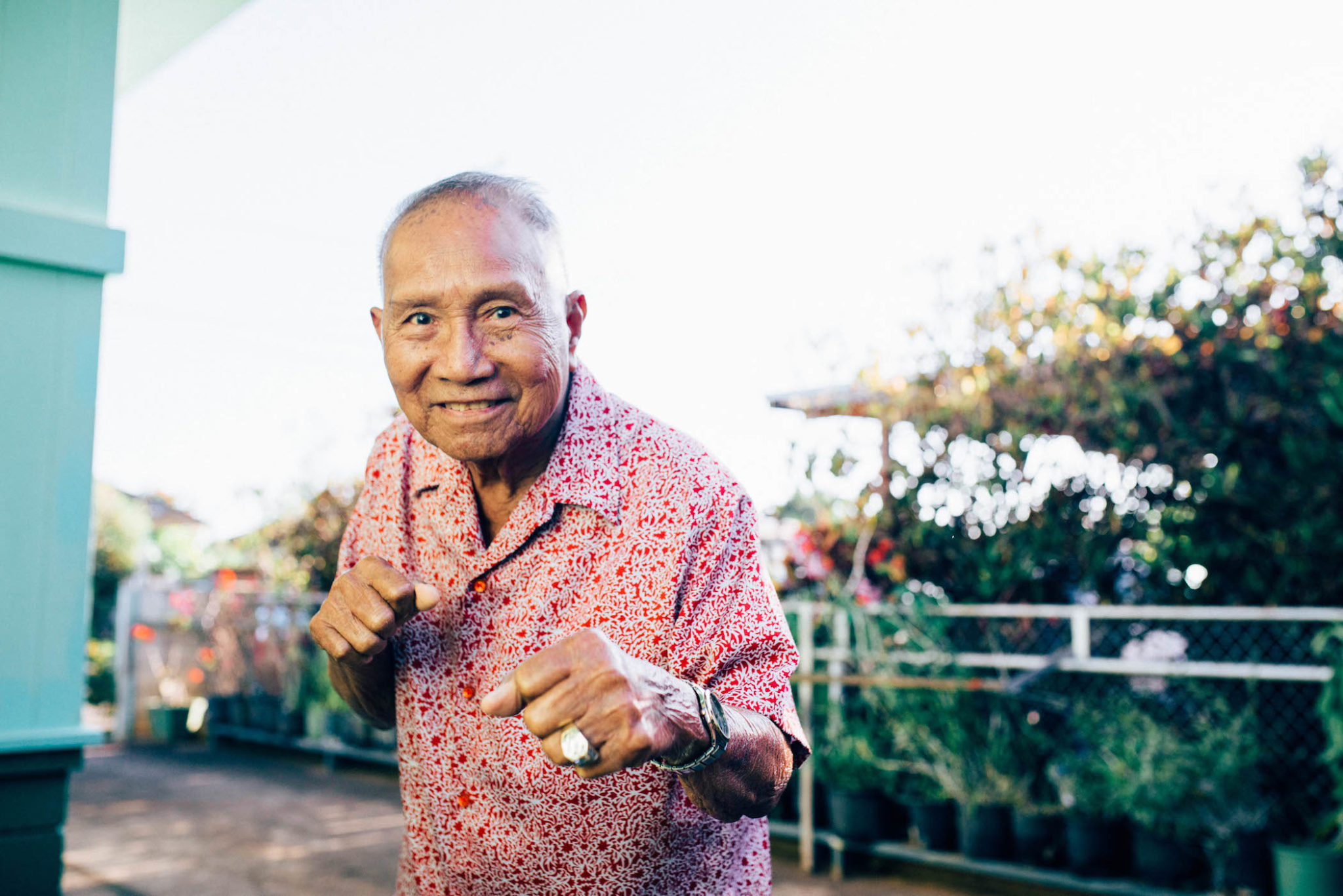Sakada Cipriano Erice recalls life on a Hawai‘i sugar plantation.
As the sun rises on a Sunday morning over a crowded but quiet loop in Waialua, Cipriano “Cipi” Erice is wide awake and full of energy. He will be 93 this year, but his infectious smile and the twinkle in his eye makes him appear years younger. “And I still drive!” he says with a laugh. “I’m lucky I still have my mind.”
Erice sits in his mint-green wooden house built right in the middle of the block—the same home he’s lived in since his arrival to O‘ahu in 1946—surrounded by other plantation homes that once housed workers of the Waialua sugar plantation. As one of roughly 6,000 Filipinos that immigrated to Hawai‘i after World War II, Erice is one of the only remaining sakadas alive to tell his tale.
Tagalog for “laborers,” sakadas were Filipino workers contracted to work in the sugar plantations of Hawai‘i starting in 1906. By the 1930s, Filipino workers outnumbered Japanese, and by the time the final wave of workers arrived in 1946, more than 100,000 laborers had come from the Philippines alone.
Leaving their lives and families behind, many of these immigrants came in search of better opportunities. They did, however, bring their Filipino customs along with them, forever changing the history and culture of Hawai‘i as a result.
As Erice remembers, it was an easy decision to leave Laoag, where he had lived in the northern Philippines. As a boy, Erice worked as a farmer and had little education. He was recruited by emissaries to the Philippines from the Hawaiian Sugar Planters’ Association, and at age 23, made the 17-day journey across the Pacific aboard the SS Moanawili, along with his four brothers. The siblings landed in Pā‘ia, Maui, and six months later, Erice was transferred to a sugar plantation in Waialua on O‘ahu.
“The first day I worked I wanted to cry. I wanted to go home. It was hard for me,” Erice recalls of his early beginnings as a sakada. He started out weeding and cutting grass for the Waialua Agricultural Company, which meant strenuous manual labor and bosses who threw around numerous phrases that he didn’t understand. His luck changed when, about a month later, he was called in to take a test that would allow him to learn a specific trade, and he passed.
“My smile was from here to here,” says Erice, pointing to each of his cheeks, beaming. Erice trained to become a welder, a role that he retained until his retirement in 1989, and soon earned the position of journeyman, a lucrative promotion that placed him at the top of the nine grades of plantation workers.
While Erice has mostly fond memories of the plantation, working in sugar in Hawai‘i was not a walk in the park. Employers demanded long work hours, enacted pay cuts often, and discriminated against workers based on race. When Erice first started at the plantation, many workers were paid very little, and couldn’t afford to send their children to college.
“You know how the boss treat us before?” he says. “They don’t call your name. They just say, ‘Hey, boy!’ We didn’t like that, so we started a union.” This union was a local chapter of the International Longshore and Warehouse Union, which represented workers in sugar and pineapple, as well as longshoreman and dockworkers. In 1952, all locales of ILWU joined forces.

“When I was in the union, I had a high education [as a tradesman], so they gave me the hard job. I declined because it was hard to be a troubleshooter,” Erice explains.
Eventually though, he was convinced, and accepted both the role and its accompanying responsibilities. He became a union officer and began meeting with management and traveling to other plantations to fight the inequalities of the plantation system.
By the 1950s, the ILWU had successfully instituted a 40-hour workweek, industry-wide medical care, sick leave, and paid vacations. Wages increased, and Erice is now proud to say that he was able to send all three of his children to college.
“I always remind my kids, it is important to study. Thanks to God, all three of them got an education. I’m really happy with that,” the sakada says, smiling.
Nearly 30 years after retiring, Erice’s face still lights up when he talks about plantation life. “I liked the sense of community. The company provided all what we needed,” says Erice, who recalls especially enjoying plantation-organized volleyball, baseball, and basketball games for the workers every Sunday.
His wife, Maring Erice—a quiet Filipina he met while on vacation to the Philippines, and brought back with him to O‘ahu years ago—pokes him in the back and interjects in Ilocano as he repeats himself.
For decades, the close-knit community of Filipino sakadas lived in the ranch-style plantation houses alongside other Japanese, Chinese, and Spanish workers. The co-laborers and neighbors often relied on each other to provide what the company did not, from sharing resources to celebrating special events.
Found on the Erices’ back patio are long communal tables and a pig-preparation station, remnants of the old plantation days that the family still uses for hosting community get-togethers. Today, they are covered in bottles, the telltale signs of last night’s successful festivities.
After 70 years in the neighborhood, the Erice house is still the center of the party.
After showing me his old stomping grounds at the Waialua Sugar Mill, Erice is off to his daily hour-long walk to the park. Or to drive his wife to church. Or to meet up with the surviving sakadas at the McDonalds in Hale‘iwa. Because for Cipriano Erice, life is still full.
Cipriano Erice is the subject of A Sakada Story, the first of a three-part documentary series by O‘ahu-raised, Filipino-American filmmaker Maribel Apuya that highlights the history of Filipino culture in Hawai‘i. For more information, visit thesakadaseries.com.
This story is part of our Migration Issue.

